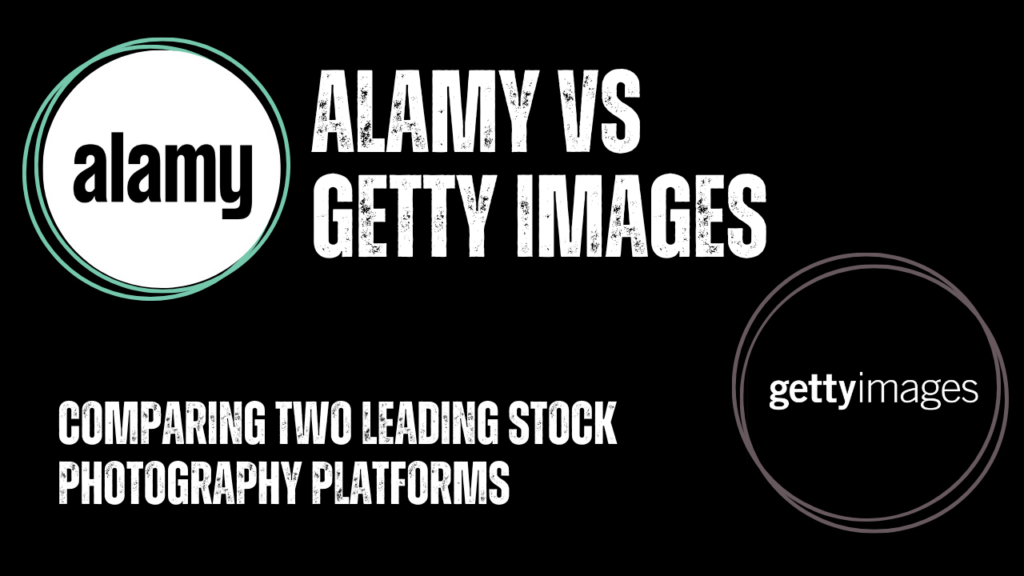Warning: Undefined array key 6 in /home/imgpanda.com/public_html/wp-content/themes/astra/template-parts/single/single-layout.php on line 176
Warning: Trying to access array offset on value of type null in /home/imgpanda.com/public_html/wp-content/themes/astra/template-parts/single/single-layout.php on line 179
Introduction
Stock photography platforms play a crucial role in the creative industry, providing a vast collection of images for various purposes. In this comparison, we will examine two leading platforms, Alamy and Getty Images, to understand their key features, offerings, and differences. Alamy and Getty Images are renowned platforms that connect photographers and content creators with potential buyers, ranging from publishers and advertisers to designers and creative professionals.
Understanding the distinctions between these platforms is essential for photographers, contributors, and buyers seeking high-quality images .By comparing Alamy and Getty Images, we aim to provide insights into their platform capabilities, licensing options, contributor experiences, customer bases, and more. This analysis will help individuals make informed decisions based on their specific needs and goals when it comes to buying or selling stock images.
Also Read This: How to Unlock Characters in My Hero Ultra Rumble
Platform Overview
Alamy and Getty Images are both prominent platforms in the stock photography industry, providing access to a vast collection of high-quality images. Understanding the background and scope of these platforms is crucial for photographers, contributors, and buyers. Alamy, founded in 1999, has established itself as a leading platform for stock photography. With a large and diverse collection of images, Alamy prides itself on offering a wide range of content from a global network of contributors. Their library encompasses various genres, styles, and subject matters, catering to a diverse customer base.
On the other hand, Getty Images has a long-standing reputation as one of the most recognizable and comprehensive stock photography platforms. Founded in 1995, Getty Images has grown into a global powerhouse, providing access to millions of premium images, illustrations, videos, and music. It has become synonymous with high-quality content and is a preferred choice for many major brands and creative professionals.
Both platforms boast extensive contributor bases, with photographers and content creators from around the world contributing to their collections. These contributors play a vital role in continuously expanding the libraries, ensuring a diverse and extensive selection of images for buyers to choose from.When comparing the two platforms, it is important to consider factors such as the size of the image libraries, the breadth of subject matter covered, and the geographic reach of their customer bases.
As we delve deeper into the comparison, we will explore the specific features, licensing options, contributor experiences, customer bases, and other aspects that differentiate Alamy and Getty Images. By understanding the unique offerings of each platform, individuals can make informed decisions about where to contribute their work or source the images that best fit their projects.
[caption id="attachment_188112" align="alignnone" width="1500"] Platform Overview[/caption]
Platform Overview[/caption]
Also Read This: Integrate Behance into Your Adobe Portfolio Website to Showcase Your Creative Work
Licensing and Usage Options
When it comes to licensing and usage options, both Alamy and Getty Images offer a range of choices to meet the diverse needs of buyers. Understanding the licensing models and usage options available on each platform is essential for photographers and buyers alike.Alamy provides a comprehensive selection of licensing options. They offer both editorial and commercial licenses, allowing buyers to use images for specific purposes. Editorial licenses are suitable for news, journalistic, or educational use, while commercial licenses cater to marketing, advertising, and promotional needs.
Getty Images, renowned for its licensing expertise, offers a wide range of licensing options as well. Their licensing models include rights-managed (RM) and royalty-free (RF) licenses. RM licenses provide specific usage rights tailored to the buyer's needs, and pricing is based on factors such as usage, duration, and exclusivity. RF licenses, on the other hand, grant broader usage rights for a one-time fee, allowing buyers more flexibility in how they use the images.
The pricing structures and royalty rates for contributors differ between the platforms. Alamy typically operates on a higher royalty rate, often considered favorable for contributors. Getty Images, with its established reputation and extensive customer base, may command higher prices for images, which can potentially result in higher earnings for contributors.It is important for photographers and buyers to consider their specific needs, budget constraints, and desired usage rights when choosing between Alamy and Getty Images.
This video explains about Alamy:
Also Read This: How to Load Fortiguard Downloader DDNS Servers List
Image Selection and Quality Control:
Both Alamy and Getty Images place a strong emphasis on image selection and quality control to ensure that their collections meet high standards. The image selection process and quality control measures on these platforms play a crucial role in maintaining the integrity and relevance of the available content. Alamy employs a comprehensive image selection process to curate their collection. When contributors upload images, they go through a review by Alamy's quality control team. The team assesses the technical quality, composition, and adherence to Alamy's guidelines, ensuring that the images meet the platform's requirements.
Similarly, Getty Images maintains a rigorous image selection and quality control process. Their team of editors carefully reviews and selects images based on strict criteria. Images are evaluated for technical quality, composition, and market relevance. Getty Images has established itself as a platform with a reputation for premium and high-quality content, making the selection process vital to upholding that standard.
Both platforms provide guidelines and resources to assist contributors in understanding the technical and content requirements for image submissions. It is important for photographers to familiarize themselves with these guidelines to ensure their images have the best chance of meeting the platforms' quality standards.
Additionally, contributors should strive to provide authentic and original content. Avoiding excessive manipulation, adhering to copyright regulations, and providing accurate captions and descriptions are essential aspects of maintaining quality and ensuring the credibility of the images. By maintaining stringent quality control measures, Alamy and Getty Images strive to offer buyers a reliable and diverse selection of high-quality images. As a photographer or contributor, it is important to pay attention to the technical aspects of your images, ensure they meet the platforms' guidelines, and continuously strive to improve the quality and relevance of your portfolio.
getty images vs alamy stock photo
— boyish prince (@kingclem69) August 31, 2020
Also Read This: Mastering the Art of Black and White Photography
Market Reach and Customer Base
The market reach and customer base of Alamy and Getty Images play a significant role in determining the potential exposure and sales opportunities for photographers and contributors. Understanding the audience and geographic scope of each platform is crucial for targeting the right market and reaching potential buyers. Alamy has a global reach, catering to a diverse customer base that spans across various industries and sectors. Their customers include publishers, advertisers, designers, and creative professionals seeking high-quality images for editorial, commercial, and personal use.
Getty Images, as one of the industry's leading stock photography platforms, has an extensive customer base that includes renowned brands, advertising agencies, media organizations, and creative professionals worldwide. With its long-standing reputation, Getty Images has built strong relationships with major clients, providing contributors with the potential for high-profile exposure and lucrative sales opportunities. Both platforms attract customers from diverse geographic regions. Alamy's global presence allows contributors to reach buyers from different countries and cultures, while Getty Images' extensive network ensures exposure to a wide range of international clients.
It is important for photographers and contributors to consider the target audience and industry focus of each platform when deciding where to contribute their work. Alamy's emphasis on a broad range of subjects and styles caters to a wide variety of buyer needs, while Getty Images' established reputation in the industry may make it a preferred choice for clients seeking premium and high-impact visual content.
As we proceed with the comparison, we will delve into the contributor experiences, support, and resources provided by Alamy and Getty Images. These factors are essential in evaluating the overall experience of photographers and contributors on each platform, as they contribute to the successful integration of images into the market and ultimately influence sales opportunities.
[caption id="attachment_188128" align="alignnone" width="1242"] Market Reach and Customer Base[/caption]
Market Reach and Customer Base[/caption]
Also Read This: Discover Your YouTube Style with This Fun Personality Quiz
Contributor Experience and Support
The contributor experience and available support are crucial aspects to consider when evaluating stock photography platforms like Alamy and Getty Images. A positive and supportive environment can greatly impact a photographer's journey and success on these platforms.Alamy offers a user-friendly registration and submission process for contributors. Setting up an account is relatively straightforward, and the platform provides clear guidelines and resources to help contributors navigate the submission process effectively.
To support photographers and contributors, Alamy provides resources such as contributor forums and educational materials. These platforms foster community engagement and knowledge sharing among contributors. Additionally, Alamy offers customer support channels to address any queries or concerns that contributors may have throughout their journey.
Getty Images also prioritizes a positive contributor experience. The platform provides a seamless registration process and offers comprehensive guidelines and resources to assist contributors in understanding the submission requirements and best practices. Getty Images maintains a robust contributor portal with access to sales reports, performance analytics, and educational materials to help contributors track their progress and optimize their portfolios.
Getty Images offers various support channels, including a dedicated contributor support team, to assist photographers with any questions or issues they may encounter. Additionally, they provide forums and community platforms where contributors can connect, learn from each other, and share experiences.
The support and resources provided by Alamy and Getty Images contribute to a nurturing environment for photographers and contributors. By leveraging these resources, contributors can enhance their skills, stay informed about industry trends, and improve their chances of success in the competitive stock photography market. It's important for photographers to explore and utilize the available support channels, engage with the community, and take advantage of the educational resources provided by these platforms.
[caption id="attachment_188127" align="alignnone" width="1500"] Contributor Experience and Support[/caption]
Contributor Experience and Support[/caption]
Also Read This: How to Make Money on Rumble with Monetization Options
FAQ
What are the similarities between Alamy and Getty Images?
- Both Alamy and Getty Images are stock photography platforms. This means that they allow photographers to sell their images to a global audience.
- Both Alamy and Getty Images have large libraries of images. Alamy has over 200 million images, while Getty Images has over 400 million images.
- Both Alamy and Getty Images offer a variety of licensing options. This means that buyers can purchase images for a variety of uses, such as editorial, commercial, and advertising.
What are the differences between Alamy and Getty Images?
- Alamy's image library is more focused on editorial content. This means that Alamy has a lot of historical, cultural, and scientific images.
- Getty Images' image library is more focused on commercial content. This means that Getty Images has a lot of images that are used in advertising and marketing.
- Alamy's pricing is more competitive. Alamy's standard licenses start at $15, while Getty Images' standard licenses start at $25.
- Getty Images has a more established brand. Getty Images is a more well-known brand, which can make it easier to sell images.
Which stock photography platform is right for me?
The best stock photography platform for you will depend on your needs and preferences. If you are looking for editorial content, Alamy is a good option. If you are looking for commercial content, Getty Images is a good option. If you are looking for a more competitive price, Alamy is a good option. If you are looking for a more established brand, Getty Images is a good option.
How do I get started selling images on Alamy or Getty Images?
To get started selling images on Alamy or Getty Images, you will need to create an account and upload your images. You will also need to choose the licensing options for your images. Once you have uploaded your images, they will be reviewed by Alamy or Getty Images. If your images are approved, they will be added to the library and you will start earning money when they are purchased.
What are some tips for selling images on Alamy or Getty Images?
- Upload high-quality images. The quality of your images is one of the most important factors that will affect your sales.
- Tag your images carefully. The tags that you use will determine how your images are found by buyers.
- Promote your images. Share your images on social media and other online platforms.
- Be patient. It takes time to build a successful stock photography business.
Conclusion:
Alamy and Getty Images are two leading stock photography platforms that provide photographers, contributors, and buyers with extensive opportunities in the industry. By comparing the key features, licensing options, image selection processes, market reach, and customer bases of these platforms, individuals can make informed decisions that align with their goals and requirements.
Alamy stands out for its wide range of content, global reach, and diverse customer base. It offers various licensing options, including editorial and commercial licenses, along with additional options like exclusive and extended licenses. With a focus on quality control and an extensive contributor network, Alamy provides opportunities for photographers to showcase their work and generate sales.
